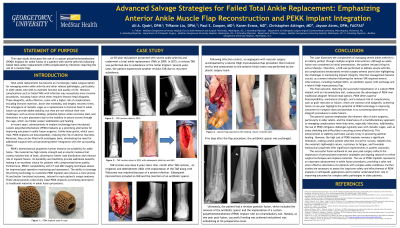Case Series/Study
(CS-124) Advanced Salvage Strategies for Failed Total Ankle Replacement: Emphasizing Anterior Ankle Muscle Flap Reconstruction and PEEK Implant Integration
Friday, May 2, 2025
7:45 PM - 8:45 PM East Coast USA Time

Christopher Attinger, MD; Jason Atves, DPM; Paul Cooper, MD; Karen Evans, MD; Tiffanie Liu, DPM; John Steinberg, DPM
Introduction: Total ankle replacement (TAR) has become an increasingly viable surgical option for managing severe ankle arthritis, particularly in older adults seeking to preserve function. However, complications such as infection and failure of TAR may necessitate invasive procedures, such as ankle fusion, which often requires the use of femoral head allografts which carry significant risks. In response to these challenges, metallic cages have emerged as an alternative to femoral head allografts. These cages offer enhanced stability but present their own set of concerns. To further optimize outcomes in failed TAR cases, especially those with severe ankle wounds, the use of an anterior ankle muscle flap is essential as a valuable adjunct in salvage surgery. By providing vascularized tissue to support the healing process, the muscle flap can help address soft tissue defects, enhance wound healing, and improve overall fusion success. This technique offers a promising alternative to the complications associated with traditional methods, potentially improving both the mechanical stability and biological environment for bone healing and wound complication.
Methods: An 83-year-old patient presented with severe ankle arthritis and underwent a total ankle replacement (TAR) in 2009. In 2015, a revision TAR was performed due to subsidence of the initial implant. Several years later, the patient experienced another revision TAR due to recurrent subsidence.
Following infection control, an angiogram with vascular surgery accompanied by a lateral thigh myocutaneous flap procedure that involved end-to-end anastomosis to the anterior tibial artery was performed by the plastic surgery team.
Results:
Discussion: This case illustrates the complexities of managing severe ankle arthritis in an elderly patient through multiple surgical interventions. Although an ankle fusion was considered at initial presentation, the patient refused citing his active lifestyle. Therefore, a TAR was performed to address severe arthritis, but complications necessitated revision surgery several years later highlighting the challenges in maintaining implant integrity. Infection management became crucial, as a severe infection following the revision TAR required several interventions, including multiple I&D’s, an antibiotic spacer with exchange and a lateral thigh myocutaneous flap.
The final outcome, featuring the successful implantation of a custom PEKK implant with an intramedullary nail. The patient's journey emphasizes the inherent risks of joint surgeries, particularly in older adults, and the importance of a multidisciplinary approach to managing complications when they arise, especially infections.
The successful fusion achieved at one year post-surgery reflects the importance of personalized treatment strategies and ongoing research to refine surgical techniques and implant materials.
Methods: An 83-year-old patient presented with severe ankle arthritis and underwent a total ankle replacement (TAR) in 2009. In 2015, a revision TAR was performed due to subsidence of the initial implant. Several years later, the patient experienced another revision TAR due to recurrent subsidence.
Following infection control, an angiogram with vascular surgery accompanied by a lateral thigh myocutaneous flap procedure that involved end-to-end anastomosis to the anterior tibial artery was performed by the plastic surgery team.
Results:
Discussion: This case illustrates the complexities of managing severe ankle arthritis in an elderly patient through multiple surgical interventions. Although an ankle fusion was considered at initial presentation, the patient refused citing his active lifestyle. Therefore, a TAR was performed to address severe arthritis, but complications necessitated revision surgery several years later highlighting the challenges in maintaining implant integrity. Infection management became crucial, as a severe infection following the revision TAR required several interventions, including multiple I&D’s, an antibiotic spacer with exchange and a lateral thigh myocutaneous flap.
The final outcome, featuring the successful implantation of a custom PEKK implant with an intramedullary nail. The patient's journey emphasizes the inherent risks of joint surgeries, particularly in older adults, and the importance of a multidisciplinary approach to managing complications when they arise, especially infections.
The successful fusion achieved at one year post-surgery reflects the importance of personalized treatment strategies and ongoing research to refine surgical techniques and implant materials.

.jpg)